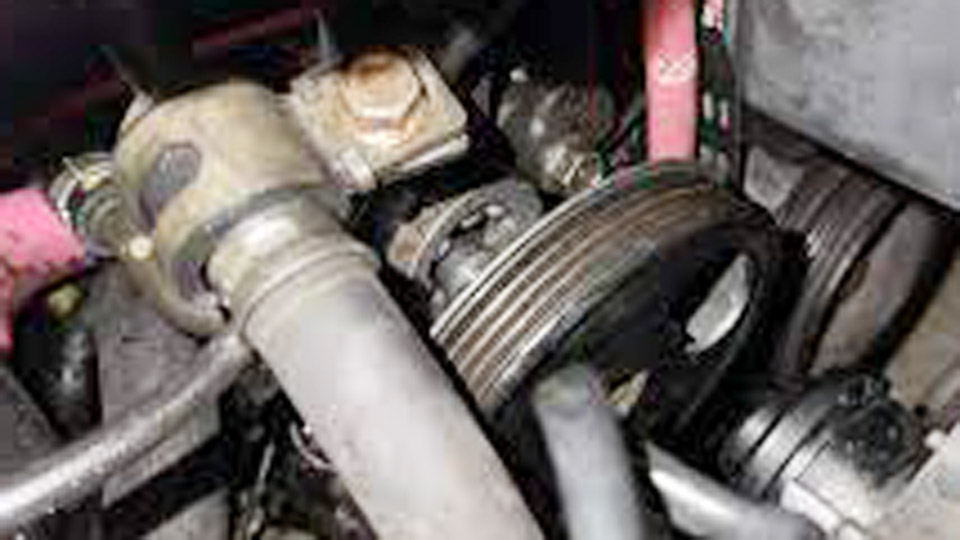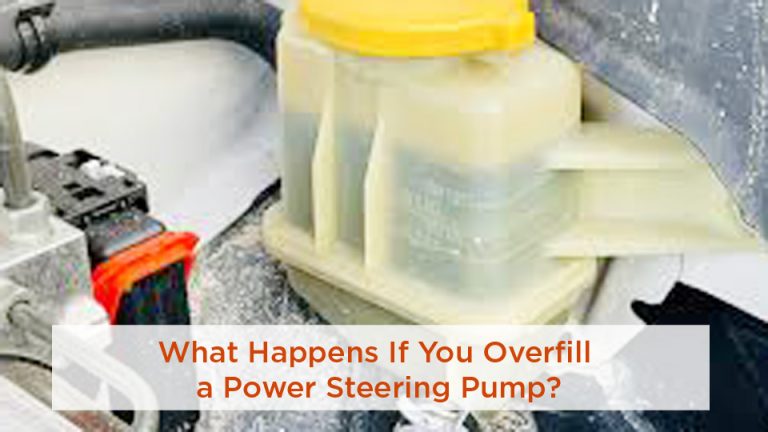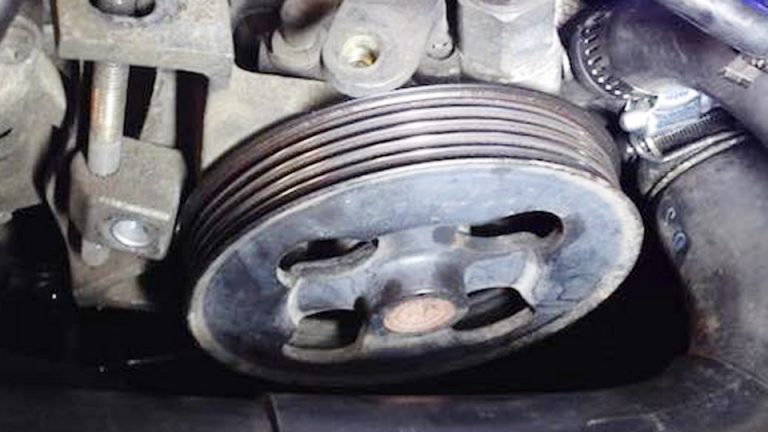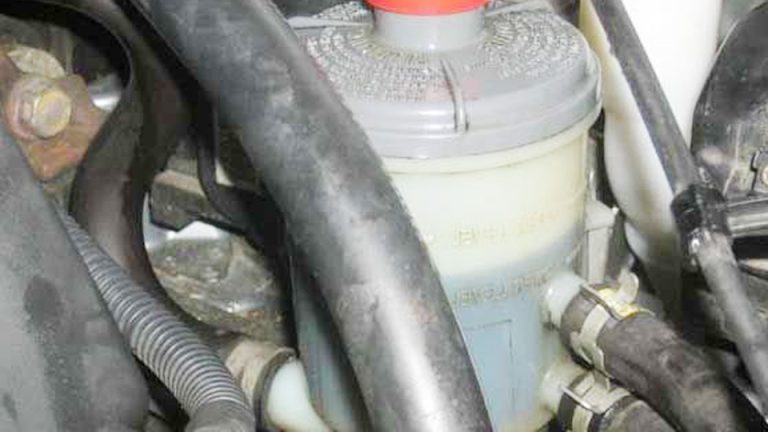When a power steering pump starts making noise, most drivers notice it right away—it’s that high-pitched whining or groaning sound when you turn the wheel, especially at low speeds or when parking. If you’re asking How Do You Fix a Noisy Power Steering Pump?, the first thing to understand is that the noise isn’t just annoying—it’s your pump telling you something’s wrong. In my experience, the most common causes are low or contaminated fluid, air trapped in the system, or a worn-out pump bearing.
Ignoring it can lead to stiffer steering, potential pump failure, and even higher repair bills down the road. I’ve worked on plenty of these, and the fix can be as simple as bleeding the system and topping up the fluid—or, in worse cases, replacing the pump entirely.

Image by reddit
What Is a Power Steering Pump and Why Does It Matter?
You’re cruising down a highway in your Toyota Camry, and without the power steering pump, turning that wheel would feel like wrestling a shopping cart with a stuck wheel. This little pump, usually belt-driven and mounted on the engine, pressurizes hydraulic fluid that flows to the steering rack or box, multiplying your input force so you don’t have to be a bodybuilder to parallel park.
Why does it matter so much? Safety first—faulty steering can lead to loss of control, especially at higher speeds or in emergencies. Performance-wise, a good pump keeps your ride responsive; a bad one makes every maneuver a chore. Cost? Ignoring it could trash the entire steering system, turning a $150 part into a $1,000 repair bill. Reliability and fuel efficiency tie in too—a struggling pump works harder, sipping more gas as the engine compensates. In my experience, I’ve seen neglected pumps cause belt slippage that overheats the engine, leading to bigger headaches.
Common problems start with wear on the vanes inside the pump or contamination from dirty fluid. Signs? That telltale whine when you turn, especially at low speeds. It’s not just noise; it’s inefficiency signaling potential failure.
Common Signs of a Failing Power Steering Pump
I’ve lost count of how many times a customer rolls into the shop complaining about “weird steering noises,” only for it to be the pump throwing a fit. The most obvious sign is the noise itself—a high-pitched whine or growl that ramps up when you turn the wheel. It’s like the pump is screaming because it’s starved for fluid or cavitating from air bubbles.
Other red flags include stiff steering that feels heavy, especially when cold, or fluid leaks around the pump housing. You might notice fluid levels dropping in the reservoir, or worse, the fluid looking milky from water contamination. In one memorable case, a buddy’s 2012 Silverado started groaning on left turns only—turned out to be a clogged return line stressing the pump unevenly.
When to replace? If the noise persists after topping off fluid and bleeding the system, or if you see metal shavings in the reservoir (a death knell for the internals), it’s time. Don’t wait; a failing pump can seize up, leaving you stranded or damaging the rack.
Diagnosing a Noisy Power Steering Pump: Step-by-Step
Before you grab the wrenches, let’s diagnose properly—rushing in is how you end up with more leaks than fixes. Start with the basics: Park on a level surface, engine off, and check the power steering fluid level in the reservoir. It should be between the min and max marks; if low, top it off with the manufacturer-recommended fluid (ATF for many domestics, PSF for imports like my old Nissan).
Fire up the engine and turn the wheel lock-to-lock a few times, listening for the noise. Does it whine only on turns? Could be normal pressure buildup. Constant whine? Pump issue. Next, inspect for leaks—look under the vehicle after a drive for red or clear fluid puddles. Feel the hoses; hot spots mean restrictions.
A quick pressure test is gold here. Hook up a gauge to the pump’s output line (you’ll need a $50 kit from AutoZone). Idle pressure should hit 100-150 PSI, spiking to 1,000+ on turns. Low? Pump’s weak. I’ve done this on a fleet of rental cars and caught failing pumps before they grenaded.
Tools you’ll need: Basic socket set, fluid catch pan, and maybe a serpentine belt tool. Safety tip: Wear gloves—power steering fluid is nasty stuff that eats skin and paint.
Common mistake? Assuming it’s always the pump. Nine times out of ten, noise comes from low fluid or a loose belt, but skipping diagnosis leads to unnecessary replacements.
Causes of Noise in Your Power Steering System
Noise isn’t always the pump’s fault, but when it is, understanding the root cause saves time and money. Aeration—air mixing with fluid—creates that bubbly whine, often from a cracked reservoir or loose hose clamps. Contaminated fluid, full of debris from neglected changes, grinds the pump’s internals like sandpaper.
Wear and tear hits harder in hot climates; I’ve fixed more pumps in Texas shops than anywhere else because heat thickens fluid, stressing the pump. Belt issues? A slipping serpentine belt mimics pump noise—check tension first.
In US vehicles like the Ford Explorer or Chevy Malibu, common culprits include the pump’s internal vanes wearing from high-mileage use (over 100k miles). Why replace? Partial fixes like flushing rarely quiet a worn pump long-term; it’s like putting a Band-Aid on a cracked engine block.
Personal insight: On a rainy afternoon, I chased a noise in my neighbor’s Jeep Wrangler that turned out to be water in the fluid from off-roading. Drained, flushed, and refilled—quiet as a mouse for another 50k miles.
OEM vs Aftermarket Power Steering Pumps: Which to Choose?
Choosing between OEM and aftermarket is like picking between a factory burger and a gourmet one—both fill you up, but one might leave you wanting more. OEM pumps, straight from the dealer like a Mopar unit for your Dodge Ram, are engineered to exact specs. They’re pricier—$200-400 for most sedans—but fit perfectly and last 100k+ miles.
Aftermarket options from brands like ACDelco (GM faithful) or Gates flood the US market at $50-150. They’re often remanufactured, tested for pressure and flow, and come with warranties. Pros: Cheaper, widely available at O’Reilly or Advance Auto Parts. Cons: Quality varies; some cheap imports fail fast, lacking the OEM’s tight tolerances.
Here’s a quick comparison table based on what I’ve installed across vehicles:
| Aspect | OEM Power Steering Pump | Aftermarket Power Steering Pump |
|---|---|---|
| Price (avg. for mid-size sedan) | $250-400 | $80-200 |
| Compatibility | Vehicle-specific, perfect fit | Broad, but check part numbers (e.g., for Honda Civic 2018-2022) |
| Durability | 100k+ miles, resists wear | 50k-80k miles; depends on brand (e.g., Duralast vs. no-name) |
| Warranty | 1-2 years from dealer | 1 year typical, lifetime on premium like Cardone |
| Pros | Exact match, quiet operation | Affordable, quick shipping from RockAuto |
| Cons | Expensive, longer wait times | Potential fit issues, shorter life in harsh use |
In the US, for domestics like Fords, go OEM if under warranty. Imports? Aftermarket from Spectra Premium works great on my Subaru. Tip: Always match the reservoir type—some pumps include it, others don’t.
To spot fakes: Genuine parts have holograms or part number engravings; counterfeits feel lightweight or have rough castings. I’ve returned more suspect Amazon buys than I care to admit—stick to reputable chains.
Step-by-Step Guide to Replacing a Power Steering Pump
Alright, time to get dirty. Replacing a power steering pump isn’t a one-hour job, but with the right steps, even a weekend warrior can nail it. I’ve done this on everything from a compact Corolla to a burly Silverado, and the key is preparation.
First, gather tools: Socket set (metric for imports, SAE for domestics), flare nut wrenches (to avoid rounding fittings), belt tensioner tool, drain pan, and fresh fluid (2-3 quarts). Safety: Jack up the front safely on stands, chock wheels, and disconnect the battery to avoid accidental starts.
Step 1: Drain the system. Place the pan under the reservoir, disconnect the return hose, and run the engine briefly to flush old fluid. Engine off, remove the serpentine belt—loosen the tensioner and slip it off the pump pulley.
Step 2: Disconnect lines. Use flare wrenches on the pressure and return lines; cap them to prevent contamination. Unbolt the pump (usually 3-4 bolts to the bracket). On V6 engines like in the Jeep Grand Cherokee, access might require removing the pulley first with a puller tool—$20 well spent.
Step 3: Install the new pump. Bolt it up snug (torque to spec: 18-25 ft-lbs typically), reattach lines hand-tight then wrench snug. Don’t overtighten—stripped fittings are a pain.
Step 4: Reinstall the belt and refill. Turn the wheel lock-to-lock with the engine off to distribute fluid, then bleed by running the engine and repeating turns. Top off as needed; it might take a few cycles to purge air.
Time estimate: 2-4 hours for a DIYer. Cost: $100-300 total. In my shop days, I’d charge $400 labor, but doing it yourself saves big.
Common mistakes? Not bleeding properly leads to persistent noise. Or reusing old fluid—always flush the system with new stuff. Anecdote: A first-timer I helped forgot to cap lines; dirt got in, and we redid the job. Lesson learned.
For rack-and-pinion setups common in modern US cars (e.g., Honda Accord), the process is similar but watch for alignment needs post-install.
Tools and Materials for Fixing Your Power Steering Pump
You don’t need a full shop to fix this, but skimping on tools turns easy into epic. Essentials: 3/8″ drive ratchet and sockets (10-18mm), open-end wrenches for hoses, and a pulley puller/installer kit—trust me, beating it off with a hammer warps the shaft.
Materials: New pump, fluid (Dexron III for many GMs, Mercon for Fords), thread sealant for fittings, and zip ties for hose routing. For bleeding, a vacuum pump helps but isn’t mandatory.
Safety gear: Gloves, eye protection—fluid sprays can blind you. Work in a ventilated area; old fluid smells like burnt rubber.
Pro tip: Rent tools from AutoZone’s loaner program—free with deposit. I’ve borrowed pulley tools countless times for oddball vehicles like older Chryslers.
Maintenance Tips to Keep Your Power Steering Pump Quiet
Prevention beats cure every time. Flush the power steering fluid every 30k-50k miles; it’s cheap insurance. Use a turkey baster for small reservoirs or a flush machine for thorough jobs. In dusty areas like the Southwest US, check filters if your system has them.
Inspect belts monthly—cracks mean slippage and noise. Keep fluid clean; top off only with the right type to avoid foaming. For high-mileage rides, add a fluid conditioner like Lucas to extend pump life.
From experience, customers who ignore maintenance end up with seized pumps. One guy drove his Escape with low fluid for months; the pump ate itself, costing $800. Regular checks? Smooth sailing.
Best practice: After any steering work, test drive at low speeds first—listen for whines and feel for stiffness.
Common Mistakes When Fixing a Noisy Power Steering Pump
I’ve seen it all: Overtightening lines that crack fittings, or skipping the bleed and wondering why the whine’s back. Big one—installing without flushing leaves debris to kill the new pump in weeks.
Another: Wrong fluid. Use ATF in a PSF system, and it foams up, causing cavitation noise. Always check your owner’s manual or RockAuto for specs.
Anecdote: Helped a student mechanic on a VW Jetta who cross-threaded a bolt—spun out the bracket hole. We helicoiled it, but it added hours. Take your time; rushing leads to redo’s.
For electric power steering in newer models (e.g., 2020+ Teslas or some Hyundais), noise might be motor-related, not hydraulic—diagnose electrically.
Pros and Cons of Different Power Steering Pump Brands
In the US market, brands shine differently. OEM like Bosch for VWs: Pros—reliable, quiet; Cons—pricey ($300+).
Aftermarket stars: Cardone reman—Pros: Affordable ($100), 3-year warranty; Cons: Occasional leaks if not primed right.
ACDelco for GM trucks: Pros: Durable in heavy use; Cons: Bulkier fit in tight engines.
Denso for Japanese rides: Pros: OEM-level quality; Cons: Scarce outside dealers.
No-name eBay specials? Pros: Dirt cheap; Cons: Fail fast, poor pressure. Stick to knowns for peace of mind.
Comparison based on installs:
- Reliability: OEM > Premium aftermarket > Budget.
- Noise reduction: All good if installed right, but cheap ones whine sooner.
I’ve swapped Cardones in fleets—hold up well for daily drivers.
Identifying Genuine vs Fake Power Steering Pumps
Fakes are rampant online, especially from overseas sellers. Genuine have crisp part numbers, smooth finishes, and branded packaging. Fakes? Rough edges, misspelled labels, or missing serials.
Weigh it—OEM feels hefty; counterfeits are light on materials. Test fit before full install; mismatches scream fake.
Buy from trusted US sources: NAPA, Pep Boys. Anecdote: A fake pump in a customer’s Prius failed after 500 miles—metal shavings everywhere. Genuine saved the day next time.
Installation Safety and Best Practices
Safety isn’t optional—power steering under pressure can whip hoses like snakes. Depressurize first: Turn wheel with engine off.
Work cold; hot fluid burns. Use jack stands rated for your vehicle weight—never just a jack.
Best practices: Torque everything—overtightening strips aluminum housings. Clean fittings before reconnect. After install, check for leaks on a test drive.
For DIYers, have a buddy spot—steering systems affect handling.
Workshop Experiences and Customer Stories
Back in the shop, a regular came in with a “haunted” steering noise on his Mustang—turned out to be a pump from a botched DIY. We replaced it, bled it right, and he was grinning ear-to-ear.
Another: A mom with a minivan, scared stiff steering was failing. Simple fluid change quieted it—no pump needed. These stories remind me why I love this work—saving folks money and stress.
Students often ask about electric vs hydraulic; hybrids mix both, but noise usually hydraulic.
Conclusion
Fixing a noisy power steering pump boils down to listening to your car, diagnosing smart, and choosing quality parts. Whether OEM for longevity or aftermarket for savings, the right fix restores that effortless turn and keeps you safe on the road. You’ll make smarter decisions by checking fluid regularly, using genuine components, and bleeding thoroughly—avoiding the pitfalls that turn minor whines into major woes.
After any pump swap, mark your calendar for a fluid check in 1,000 miles. It catches issues early and keeps your steering whisper-quiet for years.
What Causes a Whining Noise in Power Steering?
A whine usually means air in the system or low fluid—top off and bleed first. If it persists, the pump’s vanes are worn, needing replacement. Common in high-mileage vehicles over 80k.
Can I Drive with a Noisy Power Steering Pump?
Short distances, yes, but it’s risky—stiff steering can lead to accidents. Get it fixed ASAP to avoid pump seizure or rack damage.
How Often Should I Change Power Steering Fluid?
Every 30k-50k miles, or sooner in dusty/hot areas. Dirty fluid grinds the pump; fresh keeps it humming.
Is Aftermarket Power Steering Pump Reliable?
Yes, from brands like Cardone or ACDelco—I’ve seen them last 70k+ miles. Just avoid no-names; they fail quick.
What’s the Cost to Replace a Power Steering Pump?
DIY: $100-300 parts. Shop: $400-800 total. Worth the DIY if you’re handy—saves labor and teaches you the system.



